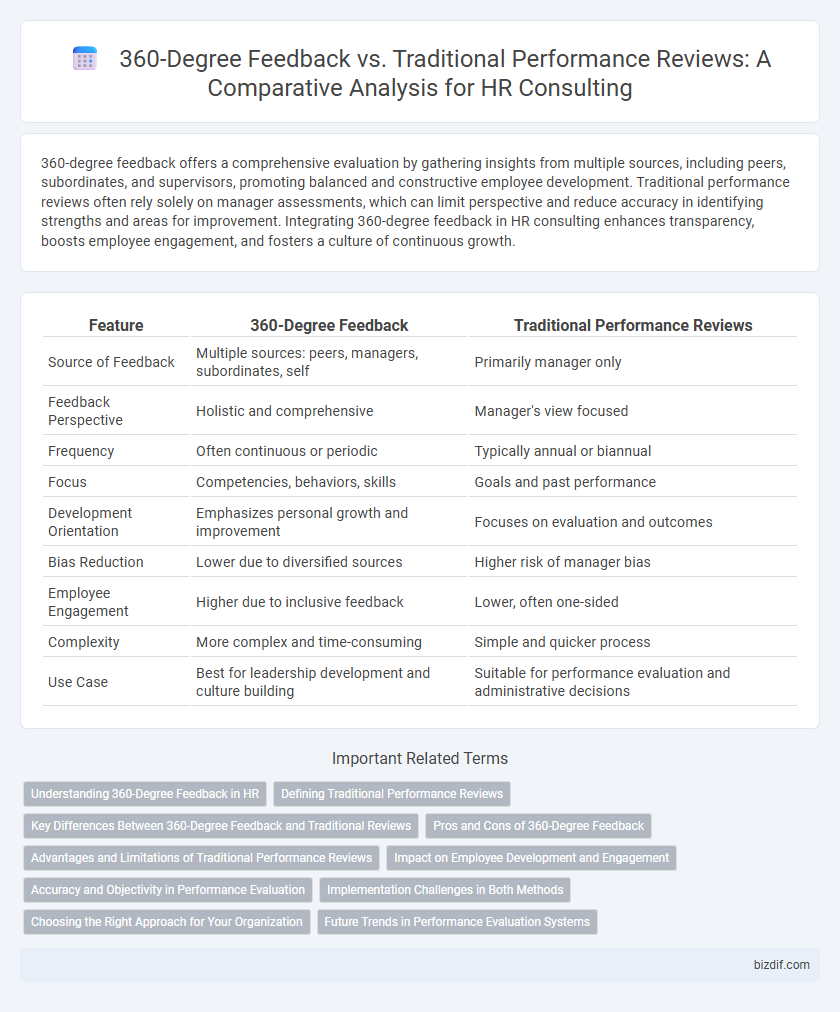360-degree feedback offers a comprehensive evaluation by gathering insights from multiple sources, including peers, subordinates, and supervisors, promoting balanced and constructive employee development. Traditional performance reviews often rely solely on manager assessments, which can limit perspective and reduce accuracy in identifying strengths and areas for improvement. Integrating 360-degree feedback in HR consulting enhances transparency, boosts employee engagement, and fosters a culture of continuous growth.
Table of Comparison
| Feature | 360-Degree Feedback | Traditional Performance Reviews |
|---|---|---|
| Source of Feedback | Multiple sources: peers, managers, subordinates, self | Primarily manager only |
| Feedback Perspective | Holistic and comprehensive | Manager's view focused |
| Frequency | Often continuous or periodic | Typically annual or biannual |
| Focus | Competencies, behaviors, skills | Goals and past performance |
| Development Orientation | Emphasizes personal growth and improvement | Focuses on evaluation and outcomes |
| Bias Reduction | Lower due to diversified sources | Higher risk of manager bias |
| Employee Engagement | Higher due to inclusive feedback | Lower, often one-sided |
| Complexity | More complex and time-consuming | Simple and quicker process |
| Use Case | Best for leadership development and culture building | Suitable for performance evaluation and administrative decisions |
Understanding 360-Degree Feedback in HR
360-Degree Feedback in HR involves gathering performance insights from multiple sources including peers, subordinates, supervisors, and self-assessments, offering a comprehensive view of employee behavior and skills. This method enhances developmental feedback by highlighting strengths and areas for improvement from diverse perspectives, increasing accuracy and reducing biases commonly found in traditional performance reviews. Organizations implementing 360-Degree Feedback benefit from improved employee engagement, targeted professional growth, and a stronger alignment with company values and goals.
Defining Traditional Performance Reviews
Traditional performance reviews involve a periodic evaluation process where managers assess employee performance based on predefined criteria, typically conducted annually or semi-annually. This method largely relies on top-down feedback, focusing on individual goals, achievements, and areas for improvement documented in formal appraisal meetings. Despite its structured approach, traditional reviews often face criticism for limited perspectives and potential biases compared to more holistic methods like 360-degree feedback.
Key Differences Between 360-Degree Feedback and Traditional Reviews
360-degree feedback gathers performance insights from multiple sources including peers, subordinates, and supervisors, offering a comprehensive view of employee effectiveness, unlike traditional performance reviews which typically rely solely on supervisor evaluations. This multi-source approach enhances accuracy and reduces bias by incorporating diverse perspectives, whereas traditional reviews may reflect limited viewpoints and potential manager biases. Moreover, 360-degree feedback fosters developmental growth and open communication, while traditional methods often emphasize evaluation and judgment.
Pros and Cons of 360-Degree Feedback
360-degree feedback collects performance insights from multiple sources, including peers, subordinates, and supervisors, offering a comprehensive view that traditional reviews often lack. This method enhances self-awareness and fosters professional growth by highlighting diverse perspectives, but it can also introduce biases and requires careful implementation to ensure constructive outcomes. Despite these challenges, 360-degree feedback promotes open communication and a more engaged workforce compared to the top-down nature of traditional performance reviews.
Advantages and Limitations of Traditional Performance Reviews
Traditional performance reviews offer a structured and straightforward approach, providing clear, periodic evaluations of employee performance based on predefined criteria. However, their limitations include potential biases from a single evaluator, lack of comprehensive feedback, and infrequent assessment intervals that may delay addressing performance issues effectively. While useful for setting goals and measuring progress, traditional reviews often miss the broader 360-degree perspectives that incorporate input from peers, subordinates, and supervisors.
Impact on Employee Development and Engagement
360-degree feedback provides a comprehensive evaluation by incorporating insights from peers, subordinates, and supervisors, leading to a more accurate identification of development needs and strengths. This holistic approach fosters greater employee engagement by promoting transparency and encouraging active participation in personal growth. Traditional performance reviews often rely on a top-down assessment, which may limit employee involvement and hinder the depth of developmental feedback.
Accuracy and Objectivity in Performance Evaluation
360-degree feedback enhances accuracy and objectivity in performance evaluations by incorporating diverse perspectives from peers, subordinates, and supervisors, reducing individual biases common in traditional reviews. Traditional performance reviews often rely on a single manager's assessment, which can limit the scope and introduce subjectivity. Incorporating comprehensive feedback mechanisms improves the reliability of performance data, leading to more balanced and actionable employee development insights.
Implementation Challenges in Both Methods
Implementing 360-degree feedback faces challenges such as ensuring anonymity to elicit honest responses and managing the complexity of collecting input from multiple sources like peers, subordinates, and managers. Traditional performance reviews often struggle with biases from single-source evaluations and limited perspectives that can affect the accuracy of employee assessments. Both methods require comprehensive training and strong organizational support to overcome resistance and ensure consistent, constructive feedback delivery.
Choosing the Right Approach for Your Organization
360-Degree Feedback offers a comprehensive evaluation by incorporating input from peers, subordinates, and supervisors, enhancing self-awareness and promoting continuous development within organizations. Traditional Performance Reviews typically involve top-down assessments centered on individual goal achievement and annual performance ratings, suitable for organizations prioritizing hierarchical clarity and structured feedback. Selecting the right approach depends on organizational culture, feedback goals, and the need for developmental versus evaluative focus to drive employee engagement and performance improvement.
Future Trends in Performance Evaluation Systems
360-degree feedback systems harness comprehensive insights from peers, subordinates, and supervisors, enhancing self-awareness and promoting continuous development. Emerging trends emphasize AI-driven analytics and real-time data integration to offer personalized, dynamic evaluations that traditional performance reviews lack. Future performance evaluation systems prioritize employee engagement, agility, and holistic performance metrics to align with evolving organizational goals.
360-Degree Feedback vs Traditional Performance Reviews Infographic

 bizdif.com
bizdif.com